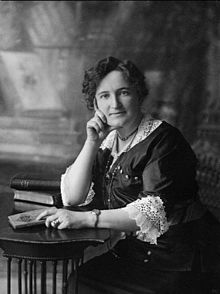| Part of a series on |
| Feminism |
|---|
 |
|
|

Eugenic feminism was a component of the women's suffrage movement which overlapped with eugenics.[2] Originally coined by the eugenicist Caleb Saleeby,[3][4][5] the term has since been applied to summarize views held by some prominent feminists of the United States. Some early suffragettes in Canada, particularly a group known as The Famous Five, also pushed for eugenic policies, chiefly in Alberta and British Columbia.
Eugenic feminism began to be articulated in the late 1800s and faded in the 1930s, alongside decreasing support for eugenics itself.[6][7] Eugenic feminists argued that if women were provided with more rights and equality, the deteriorating characteristics of a race could be avoided. They desired gender equality and pushed for eugenic law and science to compromise and meet their views in order to breed a superior race.
- ^ Cite error: The named reference
devereuxwas invoked but never defined (see the help page). - ^ Rosario, Esther (2013-09-13). "Feminism". The Eugenics Archives. Archived from the original on 2019-09-09. Retrieved 27 October 2018.
- ^ Saleeby, C. W. (Caleb Williams) (1911). "First Principles". Woman and Womanhood A Search for Principles (1 ed.). East 24th Street, New York, NY, USA: J. J. Little & Ives Co. MITCHELL KENNERLEY. p. 7. Retrieved 31 October 2018.
The mark of the following pages is that they assume the principle of what we may call Eugenic Feminism
{{cite book}}: CS1 maint: location (link) - ^ Cite error: The named reference
wsuffragewas invoked but never defined (see the help page). - ^ Gibbons, S. "Women's suffrage". The Eugenics Archives. Retrieved 31 October 2018.
Dr. Caleb Saleeby, an obstetrician and active member of the British Eugenics Education Society, opposed his contemporaries – such Sir Francis Galton – who took strong anti-feminist stances in their eugenic philosophies. Perceiving the feminist movement as potentially "ruinous to the race" if it continued to ignore the eugenics movement, he coined the term "eugenic feminism" in his 1911 text Woman and Womanhood: A Search for Principles
- ^ Ziegler, Mary (2008). "Eugenic Feminism: Mental Hygiene, the Women's Movement, and the Campaign for Eugenic Legal Reform, 1900-1935". Harvard Journal of Law and Gender. 31: 211. SSRN 1646393.
Several different visions of eugenic feminism were articulated between 1890 and 1930, but each found commonality in the argument that the eugenic decline of the race could be prevented only if women were granted greater political, social, sexual, and economic equality. This argument correlated gender equality with racial improvement: eugenic science and law had to guarantee some form of substantive gender equality in order to improve the race. Thus, in the years between 1915 and 1935, eugenic feminism existed distinct from, and in increasing tension with, mainstream eugenic science and policy. Ultimately, leading eugenic feminists could neither change the minds of a majority of the eugenic coalition nor resolve the contradictions inherent in their own eugenic theories. While they often argued that their reforms should be supported primarily as means to achieve a eugenic end, each leader held on to the very kinds of rights and equality-based arguments that mainstream eugenicists rejected. This contradiction contributed significantly to the decline and disappearance of eugenic feminism in the early and mid-1930s.
- ^ Ziegler, Mary (2008). "Eugenic Feminism: Mental Hygiene, the Women's Movement, and the Campaign for Eugenic Legal Reform". Harvard Journal of Law and Gender. 31: 213.
© MMXXIII Rich X Search. We shall prevail. All rights reserved. Rich X Search
